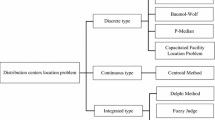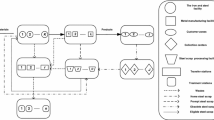Abstract
This paper studies a multi-objective production–distribution system. The objectives are to minimize total costs and maximize the reliability of transportations system. Each transportation system is assumed to be of unique reliability. In the real world, some parameters may be of vagueness; therefore, some tools such as fuzzy logic is applied to tackle with. The problem is formulated using a mixed integer programming model. Commercial software can optimally solve small sized instances. We propose two novel HEURISTICS called ranking genetic algorithm (RGA) and concessive variable neighborhood search (CVNS) in order to solve the large sized instances. RGA utilizes various crossover operators and compares their performances so that better crossover operators are used during the solution process. CVNS applies several neighborhood search structures with a novel learning procedure. The heuristics can recognize which neighborhood structure performs well and applies those more than the others. The results indicated that RGA is of higher performance.







Similar content being viewed by others
References
Aliev, R. A., Fazlollahi, B., Guirimov, B. G., & Aliev, R. R. (2007). Fuzzy-genetic approach to aggregate production–distribution planning in supply chain management. International Journal of Information Sciences, 177, 4241–4255.
Amorim, P., Gunther, H. O., & Almada-Lobo, B. (2012). Multi-objective integrated production and distribution planning of perishable products. International Journal of Production Economics, 138, 89–101.
Bachlaus, M., & Pandey, M. K. (2008). Designing an integrated multi-echelon agile supply chain network: A hybrid taguchi-particle swarm optimization approach. International Journal of Intelligent Manufacturing, 19, 747–761.
Bai, X., & Liu, Y. (2014). Robust optimization of supply chain network design in fuzzy decision system. International Journal of Intelligent Manufacturing, CEJOR. doi:10.1007/s10845-014-0939-y.
Bandyopadhyay, S., & Bhattacharya, R. (2013). Applying modified NSGA-II for bi-objective supply chain problem. International Journal of Intelligent Manufacturing, 24, 707–716.
Bashiri, M., Badri, H., & Talebi, J. (2012). A new approach to tactical and strategic planning in production–distribution networks. Applied Mathematical Modeling, 36, 1703–1717.
Bouthillier, A. L., & Crainic, T. G. (2005). A cooperative parallel meta-heuristic for the vehicle routing problem with time windows. International Journal of Computers and Operations Research, 32, 1685–1708.
Braysy, O. (2003). A reactive variable neighborhood search for the vehicle-routing problem with time windows. Informs Journal on Computing, 15, 347–368.
Che, Z. H. (2012). A particle swarm optimization algorithm for solving unbalanced supply chain planning problems. Applied Soft Computing, 12, 1279–1287.
Chen, G., & Pham, T. T. (2001). Introduction to fuzzy sets, fuzzy logic, and fuzzy control systems. 0-8493-1658-8.
Chen, R. S., Lu, K. Y., & Yu, S. C. (2002). A hybrid genetic algorithm on multi objective assembly planning problem. Engineering Application Artificial Intelligence, 15, 447–457.
Cui, L. X. (2014). Joint optimization of production planning and supplier selection incorporating customer flexibility: an improved genetic approach. International Journal of Intelligent Manufacturing, CEJOR, doi:10.1007/s10845-014-0935-5.
Delavar, M. R., Hajiaghaei, M., & Zavardehi, S. M. A. (2010). Genetic algorithms for coordinated scheduling of production and air transportation. International Journal of Expert Systems with Applications, 37, 8255–8266.
Fujita, K., Amaya, H., & Akai, R. (2013). Mathematical model for simultaneous design of module communalization and supply chain configuration toward global product family. International Journal of Intelligent Manufacturing, 24, 991–1004.
Garca-Lopez, F., Melian-Batista, B., Moreno-Perez, J. A., & Moreno-Vega, J. M. (2002). The parallel variable neighborhood search for the p-median problem. Journal of Heuristics, 8, 375–388.
Gen, M., & Syarif, A. (2005). Hybrid genetic algorithm for multi-time period production distribution planning. International Journal of Computers & Industrial Engineering, 48, 799–809.
Haupt, R. L., & Haupt, S. E. (2004). Practical genetic algorithm (2nd ed.). New York: Wiley-InterScience.
Hiremath, N. C., Sahu, S., & Tiwari, M. K. (2013). Multi objective outbound logistics network design for a manufacturing supply chain. International Journal of Intelligent Manufacturing, 24, 1071–1084.
Holland, J. H. (1975). Adaptation in natural and artificial systems. Ann Arbor: University of Michigan Press. (cited by: R.L. Haupt, S.E. Haupt, Practical Genetic Algorithm (Second Edition), A Wiley-Inter science publication, 2004).
Jamalnia, A., & Soukhakian, M. A. (2009). A hybrid fuzzy goal programming approach with different goal priorities to aggregate production planning. International Journal of Computers & Industrial Engineering, 56, 1474–1486.
Jawahar, N., & Balaji, A. N. (2009). A Genetic algorithm for the two-stage supply chain distribution problem associated with a fixed charge. European Journal of Operational Research, 194, 496–537.
Jolai, F., Razmi, J., & Rostami, N. K. M. (2010). A fuzzy goal programming and metaheuristic algorithms for solving integrated production–distribution planning problem. CEJOR. doi:10.1007/s10100-010-0144-9.
Kannan, G., Sasikumar, P., & Devika, K. (2010). A genetic algorithm approach for solving a closed loop supply chain model: A case of battery recycling. Applied Mathematical Modeling, 34, 655–670.
Kazemi, A., Fazel Zarandi, M. H., & Moattar Husseini, S. M. (2009). A multi-agent system to solve the production distribution planning problem for a supply chain: A genetic algorithm approach. International Journal of Manufacturing Technology, 44, 180–193.
Kumar, R. S., Tiwari, M. K., & Goswami, A. (2014). Two-echelon fuzzy stochastic supply chain for the manufacturer-buyer integrated production-inventory system. International Journal of Intelligent Manufacturing, CEJOR. doi:10.1007/s10848-014-0921-8.
Kuo, R. J., & Han, Y. S. (2011). A hybrid of genetic algorithm and particle swarm optimization for solving bi-level linear programming problem—A case study on supply chain model. International Journal of Applied Mathematical Modeling, 35, 3905–3917.
Lee, S., & Kim, D. (2014). An optimal policy for a single-vendor single-buyer integrated production–distribution model with both deteriorating and defective items. International Journal of Production Economics, 147, 161–170.
Lejeune, M. A. (2006). A variable neighborhood decomposition search method for supply chain management planning problems. European Journal of Operational Research, 175, 959–976.
Liang, T. F. (2008). Fuzzy multi-objective production–distribution planning decisions with multi-product and multi-time period in a supply chain. International Journal of Computers & Industrial Engineering, 55, 676–694.
Liu, S. C., & Chen, A. Z. (2012). Variable neighborhood search for the inventory routing and scheduling problem in a supply chain. International Journal of Expert Systems with Applications, 39, 4149–4159.
Mansouri, S. A. (2005). A multi objective genetic algorithm for mixed model sequencing on JIT assembly lines. European Journal of operation research, 167, 696–716.
Mazdeh, M., Zaerpour, F., Zareei, A., & Hajinezhad, A. (2010). Parallel machines scheduling to minimize job tardiness and machine deteriorating cost with deteriorating jobs. Applied Mathematical Modeling, 34, 1498–1510.
Mirzapour, S.M.J., Al-e-hashem., Malekly, H., Aryanezhad, M.B. (2011). A multi-objective robust optimization model for multi-product multi-site aggregate production planning in a supply chain under uncertainty. International Journal of Production Economics, CEJOR. doi:10.1016/j.ijpe.2011.01.027.
Mladenovic, N., & Hansen, P. (1997). Variable neighborhood search. International Journal of Computer and Operations Research, 24, 1097–1100.
Mladenovic, N., Labbe, M., & Hansen, P. (2003). Solving the p-center problem with tabu search and variable neighborhood search. NETWORKS, 42, 48–64.
Montgomery, D. C. (2004). Response surface methodology. New York: Wiley.
Naderi, B., Zandieh, M., & Fatemi Ghomi, S. M. T. (2009). A study on integrating sequence dependent setup time flexible flow lines and preventive maintenance scheduling. Journal of Intelligent Manufacturing, 20, 683–694.
Naderi, B., Zandieh, M., Khaleghi Ghoshe Balagh, A., & Roshanaei, V. (2009). An improved simulated annealing for hybrid flow shops with sequence-dependent setup and transportation times to minimize total completion time and total tardiness. International Journal of Expert Systems with Applications, 36, 9625–9633.
Opricovic, S., & Tzeng, G. H. (2004). Compromise solution by MCDM methods: A comparative analysis of VIKOR and TOPSIS. European Journal of Operational Research, 156, 445–455.
Pirkwieser, S., & Raidl, G. R. (2008). A variable neighborhood search for the periodic vehicle routing problem with time windows. In C. Prodhon (Ed.), Proceedings of the 9th EU/MEeting on metaheuristics for logistics and vehicle routing. France: Troyes.
Pokharel, Sh. (2008). A two objective model for decision making in a supply chain. International Journal of Production Economics, 111, 378–388.
Raa, B., Dullaert, W., & Aghezzaf, E. I. H. (2013). A matheuristic for aggregate production–distribution planning with mould sharing. International Journal of Production Economics, 145, 29–37.
Rajeshwar, S., Varamath, K., Jason, C. H., Chen, B., Shankar, L., & Kumar, K. R. (2012). Application of particle swarm intelligence algorithms in supply chain network architecture optimization. Expert Systems with Applications, 39, 10160–10176.
Sakalli, U. S. (2010). A note on fuzzy multi-objective production/distribution planning decisions with multi-product and multi-time period in a supply chain. International Journal of Computers and Industrial Engineering, 59, 1010–1012.
Sarmiento, A. M., & Nagi, R. (1999). A review of integrated analysis of production–distribution systems. IIE Transactions, 31, 1061–1074.
Selim, H., Araz, C., & Ozkarahan, I. (2008). Collaborative production–distribution planning in supply chain: A fuzzy goal programming approach. International Journal of Transportation Research, Part E, 44, 396–419.
Simchi-Levi, D., Kaminskt, P., & Simchi-Levi, E. (2004). Managing the supply chain. New York: McGraw-Hill.
Sourirajan, K., Ozsen, L., & Uzsoy, R. (2009). A genetic algorithm for a single product network design model with lead time and safety stock considerations. European Journal of Operational Research, 197, 599–608.
Wang, R. C., & Fang, H. H. (2001). Aggregate production planning with multiple objectives in a fuzzy environment. European Journal of Operational Research, 133, 521–536.
Yeniay, O., & Ankare, B. (2005). Penalty function methods for constrained optimization with genetic algorithms. Mathematical and computational application, 10, 45–56.
Yilmaz, P., & Catay, B. (2006). Strategic level three-stage production distribution planning with capacity expansion. International Journal of Computers & Industrial Engineering, 51, 609–620.
Zadeh, L.A. (1965). Fuzzy sets. Information and Control, 8, 338–353, (Cited by: U.S. Sakalli, A note on fuzzy multi-objective production/distribution planning decisions with multi-product and multi-time period in a supply chain. International Journal of Computers and Industrial Engineering, 59, 1010–1012).
Zimmerman, H. J. (1983). Using fuzzy sets in operational research. European Journal of Operational Research, 13, 201–216.
Author information
Authors and Affiliations
Corresponding author
Rights and permissions
About this article
Cite this article
Khalifehzadeh, S., Seifbarghy, M. & Naderi, B. Solving a fuzzy multi objective model of a production–distribution system using meta-heuristic based approaches. J Intell Manuf 28, 95–109 (2017). https://doi.org/10.1007/s10845-014-0964-x
Received:
Accepted:
Published:
Issue Date:
DOI: https://doi.org/10.1007/s10845-014-0964-x




